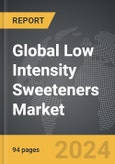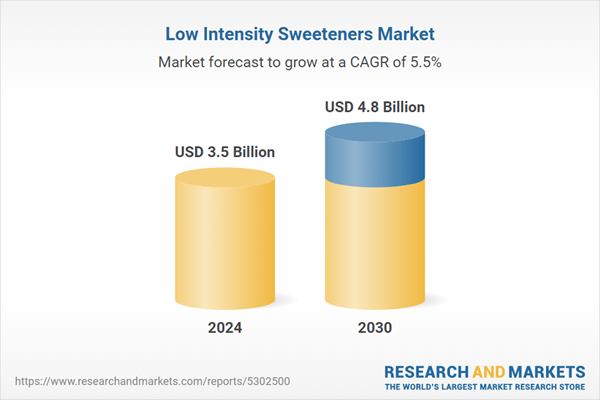The global market for Low Intensity Sweeteners was valued at US$3.5 Billion in 2024 and is projected to reach US$4.8 Billion by 2030, growing at a CAGR of 5.5% from 2024 to 2030. This comprehensive report provides an in-depth analysis of market trends, drivers, and forecasts, helping you make informed business decisions. The report includes the most recent global tariff developments and how they impact the Low Intensity Sweeteners market.
Segments: Type (Sorbitol, Maltitol, Xylitol, Allulose, Other Types); Application (Food, Beverages, Pharmaceuticals & Personal Care).
Geographic Regions/Countries: World; United States; Canada; Japan; China; Europe (France; Germany; Italy; United Kingdom; Spain; Russia; and Rest of Europe); Asia-Pacific (Australia; India; South Korea; and Rest of Asia-Pacific); Latin America (Argentina; Brazil; Mexico; and Rest of Latin America); Middle East (Iran; Israel; Saudi Arabia; United Arab Emirates; and Rest of Middle East); and Africa.
The analysts continuously track trade developments worldwide, drawing insights from leading global economists and over 200 industry and policy institutions, including think tanks, trade organizations, and national economic advisory bodies. This intelligence is integrated into forecasting models to provide timely, data-driven analysis of emerging risks and opportunities.
Global Low Intensity Sweeteners Market - Key Trends and Drivers Summarized
Why Are Low Intensity Sweeteners Gaining Popularity in Health-Conscious Markets?
Low intensity sweeteners are becoming increasingly popular as consumers shift towards healthier eating habits and seek alternatives to high-calorie sugars. Unlike high intensity sweeteners like aspartame or sucralose, which are much sweeter than sugar and used in minute quantities, low intensity sweeteners provide a more subtle sweetness that closely mimics the taste profile of sugar but with fewer calories. These sweeteners, such as allulose, tagatose, and isomaltulose, are widely used in food and beverage products like soft drinks, baked goods, and dairy products. Their lower caloric content makes them ideal for products aimed at reducing sugar intake without compromising on taste, helping to address the growing concerns around obesity and diabetes.What Innovations Are Shaping the Low Intensity Sweeteners Market?
Technological advancements in the production and formulation of low intensity sweeteners are driving innovation in this market. Manufacturers are increasingly focused on enhancing the taste profile and functionality of these sweeteners to ensure they can replace sugar without altering the texture or mouthfeel of food products. This has led to the development of improved fermentation processes and enzymatic methods for producing sweeteners like allulose and tagatose more efficiently. Additionally, blending low intensity sweeteners with natural ingredients is gaining popularity as consumers prefer products with clean labels and recognizable ingredients. These innovations are expanding the applications of low intensity sweeteners across a variety of food and beverage categories.How Do Market Segments Define the Growth of Low Intensity Sweeteners?
Product types include allulose, tagatose, isomaltulose, and others, with allulose leading the market due to its rising popularity as a sugar substitute with zero glycemic impact. Applications of these sweeteners span across beverages, bakery products, dairy, confectionery, and dietary supplements, with beverages representing the largest segment due to the increasing demand for sugar-free soft drinks and sports drinks. End-use industries include food and beverages, pharmaceuticals, and personal care, with the food and beverage sector driving the majority of the demand for low intensity sweeteners, as companies strive to reduce sugar content in their products while maintaining flavor.What Factors Are Driving the Growth in the Low Intensity Sweeteners Market?
The growth in the low intensity sweeteners market is driven by several factors, including the rising consumer demand for healthier food options, increasing rates of obesity and diabetes, and regulatory pressures to reduce sugar content in processed foods. As consumers become more health-conscious, there is a growing preference for products that offer sweetness with fewer calories. The food and beverage industry is responding by incorporating low intensity sweeteners into their product formulations to appeal to this health-conscious demographic. Additionally, the trend towards clean labels and natural ingredients is supporting the growth of low intensity sweeteners, as they are seen as a more natural alternative to high intensity artificial sweeteners.Report Scope
The report analyzes the Low Intensity Sweeteners market, presented in terms of units. The analysis covers the key segments and geographic regions outlined below.Segments: Type (Sorbitol, Maltitol, Xylitol, Allulose, Other Types); Application (Food, Beverages, Pharmaceuticals & Personal Care).
Geographic Regions/Countries: World; United States; Canada; Japan; China; Europe (France; Germany; Italy; United Kingdom; Spain; Russia; and Rest of Europe); Asia-Pacific (Australia; India; South Korea; and Rest of Asia-Pacific); Latin America (Argentina; Brazil; Mexico; and Rest of Latin America); Middle East (Iran; Israel; Saudi Arabia; United Arab Emirates; and Rest of Middle East); and Africa.
Key Insights:
- Market Growth: Understand the significant growth trajectory of the Sorbitol segment, which is expected to reach US$2.1 Billion by 2030 with a CAGR of a 6.1%. The Maltitol segment is also set to grow at 4.8% CAGR over the analysis period.
- Regional Analysis: Gain insights into the U.S. market, valued at $905.0 Million in 2024, and China, forecasted to grow at an impressive 8.4% CAGR to reach $1.1 Billion by 2030. Discover growth trends in other key regions, including Japan, Canada, Germany, and the Asia-Pacific.
Why You Should Buy This Report:
- Detailed Market Analysis: Access a thorough analysis of the Global Low Intensity Sweeteners Market, covering all major geographic regions and market segments.
- Competitive Insights: Get an overview of the competitive landscape, including the market presence of major players across different geographies.
- Future Trends and Drivers: Understand the key trends and drivers shaping the future of the Global Low Intensity Sweeteners Market.
- Actionable Insights: Benefit from actionable insights that can help you identify new revenue opportunities and make strategic business decisions.
Key Questions Answered:
- How is the Global Low Intensity Sweeteners Market expected to evolve by 2030?
- What are the main drivers and restraints affecting the market?
- Which market segments will grow the most over the forecast period?
- How will market shares for different regions and segments change by 2030?
- Who are the leading players in the market, and what are their prospects?
Report Features:
- Comprehensive Market Data: Independent analysis of annual sales and market forecasts in US$ Million from 2024 to 2030.
- In-Depth Regional Analysis: Detailed insights into key markets, including the U.S., China, Japan, Canada, Europe, Asia-Pacific, Latin America, Middle East, and Africa.
- Company Profiles: Coverage of players such as Cargill, Incorporated., Hyet Sweet, Ingredion, Matsutani Chemical Industry Co., Ltd., Mitsui and Co., Ltd. and more.
- Complimentary Updates: Receive free report updates for one year to keep you informed of the latest market developments.
Some of the 43 companies featured in this Low Intensity Sweeteners market report include:
- Cargill, Incorporated.
- Hyet Sweet
- Ingredion
- Matsutani Chemical Industry Co., Ltd.
- Mitsui and Co., Ltd.
- PureCircle
- Roquette Frères
- Südzucker
- SweetLeaf® Stevia Sweetener
- Tate and Lyle
Tariff Impact Analysis: Key Insights for 2025
Global tariff negotiations across 180+ countries are reshaping supply chains, costs, and competitiveness. This report reflects the latest developments as of April 2025 and incorporates forward-looking insights into the market outlook.The analysts continuously track trade developments worldwide, drawing insights from leading global economists and over 200 industry and policy institutions, including think tanks, trade organizations, and national economic advisory bodies. This intelligence is integrated into forecasting models to provide timely, data-driven analysis of emerging risks and opportunities.
What’s Included in This Edition:
- Tariff-adjusted market forecasts by region and segment
- Analysis of cost and supply chain implications by sourcing and trade exposure
- Strategic insights into geographic shifts
Buyers receive a free July 2025 update with:
- Finalized tariff impacts and new trade agreement effects
- Updated projections reflecting global sourcing and cost shifts
- Expanded country-specific coverage across the industry
Table of Contents
I. METHODOLOGYII. EXECUTIVE SUMMARY2. FOCUS ON SELECT PLAYERSIII. MARKET ANALYSISSOUTH KOREAREST OF ASIA-PACIFICARGENTINABRAZILMEXICOREST OF LATIN AMERICAIRANISRAELSAUDI ARABIAUNITED ARAB EMIRATESREST OF MIDDLE EASTIV. COMPETITION
1. MARKET OVERVIEW
3. MARKET TRENDS & DRIVERS
4. GLOBAL MARKET PERSPECTIVE
UNITED STATES
CANADA
JAPAN
CHINA
EUROPE
FRANCE
GERMANY
ITALY
UNITED KINGDOM
SPAIN
RUSSIA
REST OF EUROPE
ASIA-PACIFIC
AUSTRALIA
INDIA
LATIN AMERICA
MIDDLE EAST
AFRICA
Companies Mentioned (Partial List)
A selection of companies mentioned in this report includes, but is not limited to:
- Cargill, Incorporated.
- Hyet Sweet
- Ingredion
- Matsutani Chemical Industry Co., Ltd.
- Mitsui and Co., Ltd.
- PureCircle
- Roquette Frères
- Südzucker
- SweetLeaf® Stevia Sweetener
- Tate and Lyle
Table Information
| Report Attribute | Details |
|---|---|
| No. of Pages | 94 |
| Published | April 2025 |
| Forecast Period | 2024 - 2030 |
| Estimated Market Value ( USD | $ 3.5 Billion |
| Forecasted Market Value ( USD | $ 4.8 Billion |
| Compound Annual Growth Rate | 5.5% |
| Regions Covered | Global |









